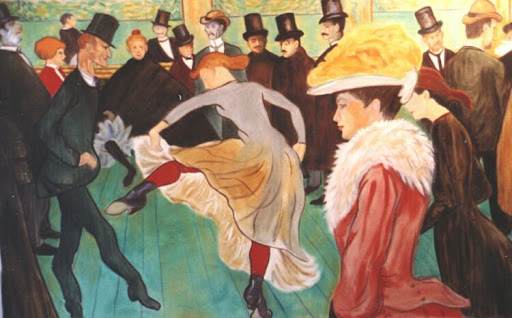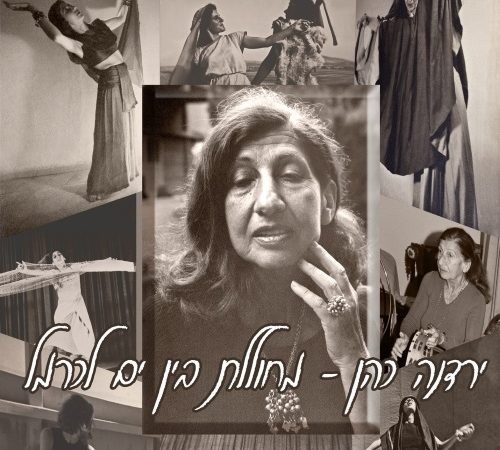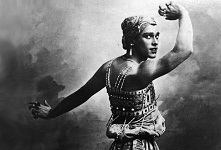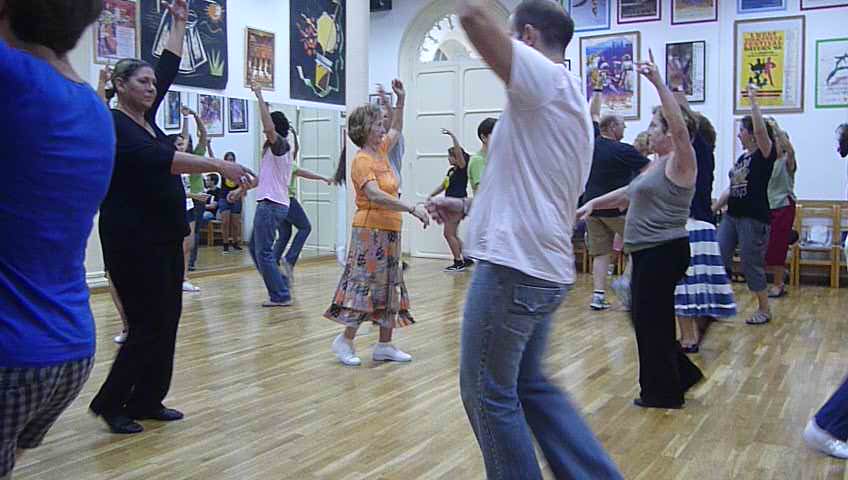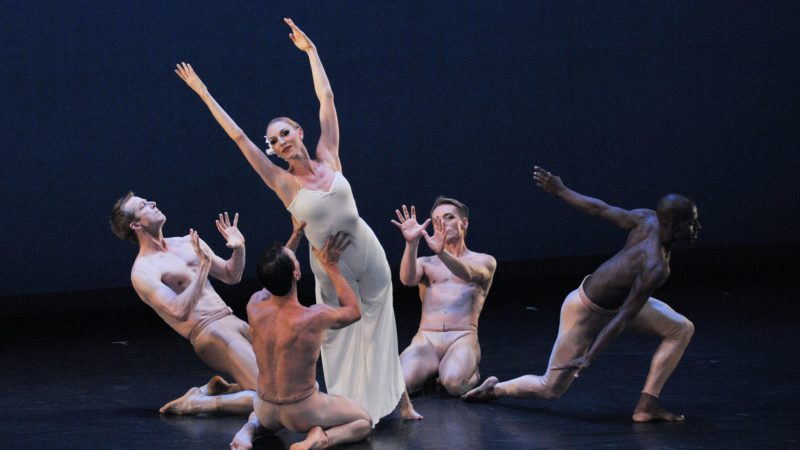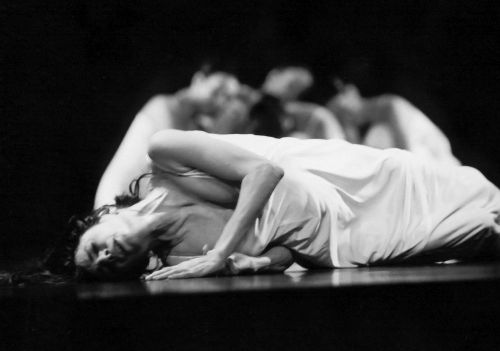Drawing out the Connections between the Past and the Present
The Lost Dances of Egon Schiele, a video-dance, was created in 2002 by the contemporary British choreographer Lea Anderson and Kevin McKeirnan for her all-male group, The Featherstonehaughs. It was based on The Featherstonehaughs Draw on the Sketch Books of Egon Schiele, a dance that was first performed in London, 1998. Anderson started to choreograph in 1984, with the foundation of her all-female company, The Cholmondeleys (pronounced Chumlees). After establishing a second company, The Featherstonehaughs (pronounced Fanshaws), in 1988, which was concerned with images of masculinity, Anderson’s reputation as a leading choreographer was assured (Hargreaves, 2002).
Anderson, who appropriates Egon Schiele’s painterly images and makes them her own is not the first choreographer to work within hybrid, time-shifting genres across dance and painting. Her mode of re-working this genre, however, generates new manifestations in postmodern culture, which differ from all their antecedents in crucial respects. The process of making the dance, she acknowledges, involved sticking closely to Schiele’s pictures, instead of her own. She combines the conventions he used, of pictorial art movements and gestures, the flat surface, colour and the rhythm of brush strokes – with her own discipline. Anderson’s choice of images show her representing not only the movements and gestures of Schiele’s models but re-constructing an artistic structure within which they could be performed. She copies Schiele’s movements and gestures only to incorporate them into another aesthetic, that of a contemporary dance.
Schiele, whose art is appropriated by Anderson into her own artistic medium, is regarded by art historians as one of the major exponents of Viennese Expressionism (for example Kallir, 1981, Comini 1978). He produced in his short lifetime (1890-1918) an oeuvre of paintings and drawings ranging from landscapes to provocative nudes that shocked society.
The Lost Dances of Egon Schiele is more than a bringing together of the arts of dance and painting. Anderson’s engagement with Schiele’s art becomes a point of departure for another distinctive hybrid relationship, between British postmodernism of the late twentieth century and Viennese Expressionism of the early twentieth century. The work shows a postmodern choreographer playing with modern concepts of art. These relationships, however, become problematic since the work challenges modernist art while, at the same time, creating a link with the past by addressing it and recalling it visually. Through this process Anderson undermines some of the profound characteristics of modernism – uniqueness and authenticity – and thus expresses her own views of Schiele’s art and of Expressionism, as well demonstrating, wittily, the relevance of these ideas to our time.
Thus I point to the way Anderson confronts and juxtaposes memory and modes of representation in both the art of dance and painting. Anderson challenges traditions through her employment of deconstruction and pastiche. The argument here is that the specific manifestations of Anderson’s play with the past and the present endow the past with meaning in the present. The issue raised in consequence, from a historical point of view, does the return to a model of art from the past supports the development of a new practice or challenge it? The engagement with appropriation as a critical tool, not of documentation, but of knowingly representing the past brings about a need to discuss the complexity of representation operated by Anderson and how it is different from what was done before.
When Anderson uses Schiele’s drawings and paintings as sources for her dance, she makes his Expressionist art her point of departure, not the ‘subject’ of her work. Shifting Schiele’s art from its usual place in our culture and transforming its traditions, the distance that separates us from what Schiele’s sketch books offer and repress becomes the subject of the dance. As she takes a fresh look at the historical record of modernist Expressionism, Anderson must find ways to relate her own work of art not only to another art, but also to another era. The physicality of Schiele’s work, Anderson declares, inspires, appeals and strongly suggests choreography to her. Raw material – Schiele’s movements and gestures – is transformed into dance, given shape and form. She speaks of her attempt to reproduce his sketch books: “…I suddenly thought, I wonder what it would be like if I just reconstructed the ‘Lost Dances’ of Egon Schiele?” (in Robertson, 1998, p. 19). Conceptually, representation in Anderson’s artistic work is based on Schiele’s actual drawings and paintings. However, Anderson subjects Schiele's artistic qualities, which she describes as distinguished by “rawness and sense of exposure” (in Hutera, 1998, p. 34), to her own needs.
As a term, ‘representation’, while complex, is often seen to have two basic meanings (Prendergast, 2000). The first lies in the capacity to ‘make present again’, the reappearance of an absent person or object by means of a simulacrum. The second meaning of representation, standing for something or someone absent, rests on a principle of substitution. While there can be only one kind of simulacrum, there can be many kinds of substitution, which is a wider sense of representation that can, in theory, cover the entire field of culture. Representation within contemporary culture is complex, and can behave in “a whole variety of different ways according to context, intellectual discipline, and object of inquiry” (Prendergast, 2000, p. 3). Dance critics and scholars advance the referential view of Anderson’s choreographic art and tie her work with various themes and discourses, such as popular culture, video dance or gender issues, also demonstrating her socio-political engagement with ideas and non-dance sources (see for example Dodds, 1995; Briginshaw 1995; Burt, 1998 and Jordan 1988).
My argument, however, is that one can read Anderson’s dance as both referential and simulacral, oscillating between the two primary meanings of artistic representation – ‘making present’ and ‘standing for’. However, although both concepts of representations coexist within Anderson’s choreography, I argue that the concept of representation as ‘standing for’ is a more significant mechanism. The added value of the theoretical ideas and discourses embodied in the dance are what make it more attractive and interesting.
The ‘naked’ dancer who is posing on a mattress is aware of the spectator/artist looking through the camera lens. The spectator/artist watches the dancer move and pose before him or her with his legs wide apart, placing his hands over his genitals and raising his pelvis. Anderson uses poses that are similar to those of Schiele’s subjects, but at the same time draws the audience’s attention to the relationship established between artist and model, a distinct theme in pictorial art. This manifestation of the chain of gazes comprises spectators/artist, model/dancer, and exposes the dancer/model as both an object and voyeur. Anderson, however, pushes this theme further when enabling the audience to become consumers, not of feminine sexuality as in Schiele’s paintings and drawings, but of images of male sexuality as objects of desire.
As Prendergast (2000) suggests, the association between representation and power is embedded in a referential (‘standing for’) relation to representation. Furthermore, in contemporary critical theory the emphasis moves from the object of representation to the subject of representation (which is not necessarily an individual). One aspect of this displacement of attention is “the notion of the representational field as a field to be policed and the subject of representation as a kind of policing agent” (Prendergast, 2000, p. 11).
This is exemplified when the dancer looks at the audience, who watch the intimate occurrence on stage. I argue that Anderson creates a powerful female spectator’s look, avoiding what Laura Mulvey refers to as a certain ‘masculinisation’ of spectatorship (in Doane, 1982). The woman spectator, no longer the image, obtains her desire in relation to the process of imaging.
In consequence, questions of representation can also become questions of politics in a broad sense of the term. Applying this to an interpretation of Anderson’s dance, the complexity of form and pattern suggests a type of expressionism that is different from Schiele’s picturesque use of structure and space in that it shifts the attention towards the subject, towards the way Anderson exposes and transforms his notions of Expressionist art.
When Anderson is quoted as saying that “every single position [in the dance] comes from a painting or sketch of his [Schiele’s]”, the simulacral meaning of the dance becomes apparent (in Hutera, 1998, p. 34). At the same time, like Schiele’s paintings and drawings, the dancers expose and present their emotions as well as their flesh. Anderson’s desire to substitute Schiele’s art is evoked by the sense of exposure portrayed in Schiele’s paintings and drawings. The traces of the past found in Anderson’s present work are represented as a duality between two layers of time, past and present. These are juxtaposed in a postmodern manner, remaining separate in the dance, and the resulting contradiction between the two narratives is not resolved; rather, they coexist heterogeneously (Hutcheon, 1989).
When Anderson draws on the discourse of the relationship between the artist and model, revealing the field of power and its limitations, she demonstrates that every point of view is only a relative one, and the spectator’s point of view is not the ultimate or definite one. In doing so she indicates her self-awareness and up-to-date knowledge of art history and cultural theories, which she incorporates into her video-dance. Furthermore, Schiele, like his predecessors, had no doubts in his art and did not use either irony or any other means that might provoke the audience to disbelieve him. Anderson, who imitates and exaggerates Schiele’s poses and facial expression sometimes provoking laughter, draws on this discourse to present it in her dance with irony and pastiche.
The dance works with two distinctive sets of images: those from Schiele’s sketch books and the choreographer’s images – and the space or vibration between them. Anderson challenges the traditional representational model of the relationship between the inner and the outer, the subjective and objective world, as expressed by Schiele’s art; at the same time, she enables the changes that have transpired since that time to become visible in her dance in, for example, the ‘mock-nude’ costumes in the dance which indicate some reflection about the construction of eroticism and how desire is to be expressed on the outside of the body. The dancers’ ‘skin’ is painted with Schiele’s coloured brushstrokes; but while Schiele expressed his inner feelings on the flesh of his female models, it is male dancers that Anderson and her costume designer Sandy Powell dress in tights. This might point to Anderson’s interest in fluid gender identities.
Anderson has long focused on stereotyped definitions of gender identities and heteronormative culture in a way which is characteristic of contemporary feminist critique, and which simultaneously conveys a political message. Anderson formulates her critical message by emphasising the area of Schiele’s appropriated ‘normative’ art. She presents a woman artist’s desire for a male artist who desires other women. This is presented by male dancers representing women/models and at the same time longing for other male dancers performing on stage. Thus, Anderson unravels Schiele’s ways of looking at the world and constructs her own view of it.
Artistic representation, which is traditionally perceived in visual arts as a field of vision shaped like a triangle, places the subject of vision at its apex. Prendergast (2000) uses Barthes’ (1973) model of representation, a dual one in which his geometric metaphor of a formal model of representation is directed less at objects than at the process of representation. Similarly, Anderson’s dance not only focuses the audience’s attention on the art of Schiele – an artist who was breaking taboos and challenging fin-de-siècle culture in Vienna as well as a product of his time, but also draws attention to Anderson herself as an author. She examines representations within the structures and operations of her dance very differently from Schiele, indirectly, through manipulations of various theoretical discourses borrowed from visual art. Consequently, the complexity of representation in Anderson’s dance becomes an active force, which is part of the entire structure rather than an expressive device.
Anderson’s play with Schiele’s art within her dance emphasises the distance and fluctuation between the two, and becomes her point of departure. Appropriating Schiele’s exact images becomes a critical tool to challenge what Connor (1997) argues is the impossibility of representation in modernist culture. Anderson’s application of imitation and pastiche as a critical device enables her to deconstruct the conventional and accepted meaning of Schiele’s art.
In the last analysis, what matters are not the various issues referred to in themselves, but the web-like structure of the text. It is demonstrated when pictorial ideas of another style and time penetrating and enriching the dance, and the engagement with such discourses which undermines normative power structures. The final interpretative task is left to the spectator/reader.
References
This paper I submitted at the 31st Annual SDHS conference "Looking Back / Moving Forward",. The conference was held in 2008 (June 12-15) at Skidmore College Saratoga Springs, NY.
Barthes, Roland. “Diderot, Brecht, Eisenstein” in Revue d’Esthétique, Vol. 26, 1973, pp. 185-191.
Briginshaw, Valerie. Lea Anderson Talks to Valerie Briginshaw about Flesh and Blood. Dance Matters 13, Summer 1995, pp. 4-8.
Burt, Ramsay. Re-Presentations of Re-Presentations. Dance Theatre Journal 14:2, 1998, pp. 30-33.
Comini, Alessandra. The Fantastic Art of Vienna. New York: Alfred A. Knopf, 1978.
Connor, Steven. Postmodernist Culture: An Introduction to Theories of the Contemporary. Oxford: Blackwell, 1997.
Doane, Mary Ann. “Film and the Masquerade: Theorising the Female Spectator”. Screen 23:3-4, Sept-Oct 1982, pp. 74-88.
Dodds, Sherril. “‘Perfect Moments, Immaculately Framed’: Lea Anderson and the Television Text”. Border Tension: Dance & Discourse. Proceedings of the Fifth Study of Dance Conference, Guildford, University of Surrey, April 20-23, 1995.
Hargreaves, Martin. “Profile Lea Anderson”. Dance Theatre Journal, 18:3, 2002, pp. 16-19.
Hutcheon, Linda. Modelling the Postmodern: Parody and Politics. A Poetics of Postmodernism: History, Theory, Fiction. London: Routledge, 1989, pp. 22-36.
Hutera, Donald. “The Boys get into a Viennese Whirl”. The Times, 10 February 1998, p. 34.
Jordan, Stephanie. The Cholmondeleys, Spring '88. Dance Theatre Journal 6:2, Fall 1988, p. 27.
Kallir, Jane. Austria’s Expressionism. New York: Rizzoli, Galerie St. Etienne, 1981.
Prendergast, Christopher. The Triangle of Representation. New York: Columbia University Press, 2000.
Robertson, Allen. “G’day Schiele!” Time Out, 31 December – 7 January 1998, p. 19.
Videography
Anderson, Lea and McKeirnan, Kevin. The Lost Dances of Egon Schiele, BBC and the Arts Council of England, 2002.
